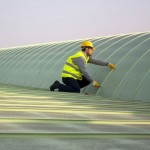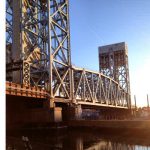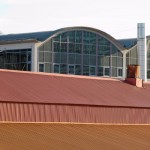November 4, 2014, 10:38 am | by Ray Nardo
 Rooftops are among the most common elevated areas where general industry work is performed. But they are also one of the most common areas where injuries or deaths occur as a result of a fall.
Rooftops are among the most common elevated areas where general industry work is performed. But they are also one of the most common areas where injuries or deaths occur as a result of a fall.
The types of work performed on rooftops is wide-ranging. It isn’t just limited to roofing contractors. School janitors may need to venture up to retrieve a lost soccer ball. Office maintenance or physical plant personnel may need to go up to clean out the gutters, or to remove snow in winter. Read more.
July 11, 2014, 10:00 am | by Ray Nardo
Railroad Bridge Netting Installation
 FallProof recently completed the last phase of a four-phase railroad bridge netting project for a major public transportation company in the State of New York. This particular project involved the netting of a 440-foot long lift bridge that spans mostly water. This involved the unique challenge of completing the entire project from a barge. We installed personnel-rated netting underneath the span, thus, providing an OSHA-compliant solution for fall protection, eliminating the need for workers to tie off while conducting maintenance and track replacement. The netting also served the two-fold purpose of debris collection. As part of the project we cleaned and inspected the existing nets. Read more.
FallProof recently completed the last phase of a four-phase railroad bridge netting project for a major public transportation company in the State of New York. This particular project involved the netting of a 440-foot long lift bridge that spans mostly water. This involved the unique challenge of completing the entire project from a barge. We installed personnel-rated netting underneath the span, thus, providing an OSHA-compliant solution for fall protection, eliminating the need for workers to tie off while conducting maintenance and track replacement. The netting also served the two-fold purpose of debris collection. As part of the project we cleaned and inspected the existing nets. Read more.
April 25, 2014, 11:19 am | by Ray Nardo
 Rooftop fall protection is a necessity for keeping your workers safe while they perform tasks atop buildings. OSHA 1926.501(b)(1) states: “Unprotected sides and edges. Each employee on a walking/working surface (horizontal and vertical surface) with an unprotected side or edge which is 6 feet (1.8 m) or more above a lower level shall be protected from falling by the use of guardrail systems, safety net systems, or personal fall arrest systems.” Read more.
Rooftop fall protection is a necessity for keeping your workers safe while they perform tasks atop buildings. OSHA 1926.501(b)(1) states: “Unprotected sides and edges. Each employee on a walking/working surface (horizontal and vertical surface) with an unprotected side or edge which is 6 feet (1.8 m) or more above a lower level shall be protected from falling by the use of guardrail systems, safety net systems, or personal fall arrest systems.” Read more.
 Rooftops are among the most common elevated areas where general industry work is performed. But they are also one of the most common areas where injuries or deaths occur as a result of a fall.
Rooftops are among the most common elevated areas where general industry work is performed. But they are also one of the most common areas where injuries or deaths occur as a result of a fall.


